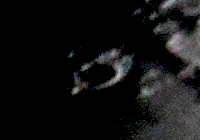
Mercury, Venus, Jupiter, Moon, and Saturn
Posted: 19 May 2013
Clouds prevented observing on Friday, 17 May 2013, but two more pack rats were captured near the observatory during the day. Another one was captured on Saturday. They were all released miles away. That makes nine live pack rats and two dead pack rats since we started trapping them in mid-April 2013. We removed two more pack rat nests on Saturday. We are removing the pack rat nests near the observatory in order to mitigate the evening Kissing Bug activity at the observatory (typically begins in late May and early June). I plan to spray where the pack rat nests were located next week. There is one more nest to be removed (I hope).
The sky cleared on Saturday, 18 May 2013, and Cassiopeia Observatory was opened at 1847 MST, 86°F. The sky was clear but there were strong breezes. I powered on the 8" LX200-ACF at 1854 MST. During the previous session, I changed the PEC settings to avoid the 15° RA slew at startup. Now I miss having that slew as it was an excellent indicator that the telescope was ready to use when the slew was completed. Without the startup slew, I have to check the AutoStar display to confirm the telescope is ready.
At 1858 MST, viewed the nearly First Quarter moon, 83X. The craters Murchison and Pallas looked interesting this evening. I considered doing some high magnification imaging of them, if the seeing improved.
At 1918 MST, viewed Mercury, 83X, through some tree branches. Then Venus, also through tree branches. Both planets showed nearly the same gibbous phase. Next was Jupiter. It was higher in the sky, but poor seeing allowed only the north and south equatorial belts to be seen.
Returned to the moon for some lunar observing using 222X. Seeing was still bad. I decided to grab a quick prime focus image of this night's moon using the D7000 DSLR. This is 1/320sec, ISO 400:

Seeing was not good enough for high magnification imaging of the craters Murchison and Pallas. This next image, copied from the above prime focus image, shows the two craters:

I resumed lunar observing at 1943 MST using 222X. Crater Fontenelle at the terminator was a nice sight. The top of the crater rim was brightly illuminated all the way around, with the crater floor still black. This image, also cropped from the above prime focus image and highly edited, gives a hint of what the crater looked like:

At 2003 MST, viewed Saturn, 222X. Due to the poor seeing this night, I decided to end the session.
The observatory was closed at 2020 MST, 71°F.
Meade Instruments announces merger!!! Details at:
http://finance.yahoo.com/news/meade-instruments-corp-announces-merger-213327726.html
Full agreement (PDF).
Comments are welcome; use the Comments section below, or you can Email Me. Thanks.
Cassiopeia Observatory Home Page